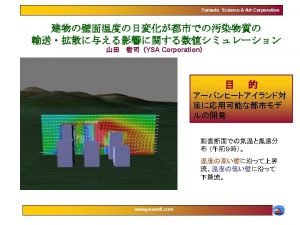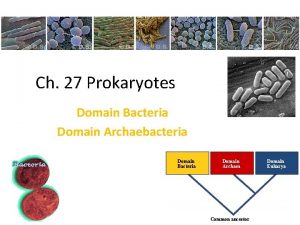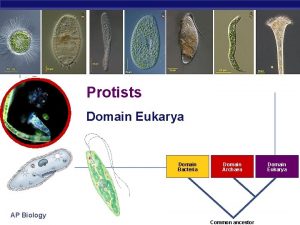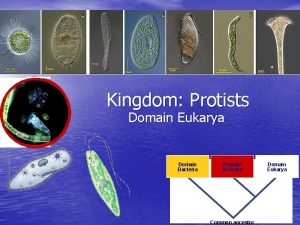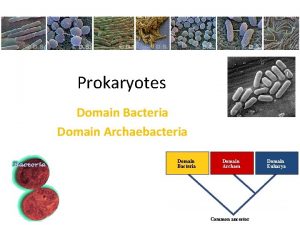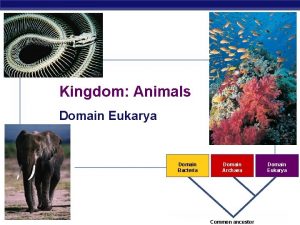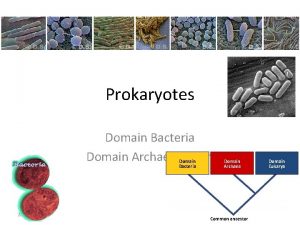COMMUNICATIONS IN THE OPTICAL DOMAIN Parimal Ghosh Assistant
















- Slides: 16

COMMUNICATIONS – IN THE OPTICAL DOMAIN Parimal Ghosh Assistant Professor Department of Physics (PG & UG) Banwarilal Bhalotia College P O – Ushagram, Asansol – 713 303 Phone No – 0341 2274842 (O), 09434147190 (M) E-mail: parimal 34@gmail. com 22 -03 -2015 P Ghosh, B B College, Asansol 1

Deliberation – at a glance q Introduction – modern communications and the necessity of communications in optical domain q First optical AM Link– Graham Bell’s the photo-phone q EM Spectrum and communications q Few historical milestones of OFC q Bandwidth and its importance in Communication q Optical Fiber – The ocean of Bandwidth q Advantages of OFC q Few Application areas of OFC q Limitations of OFC q Concluding remarks – future prospects 22 -03 -2015 P Ghosh, B B College, Asansol 2

q o INTRODUCTION What is Communication ? To communicate (Latin word ‘communico’ means to share) with any one at any place at any time is the ultimate goal of communications, i e, one to many and that many need not be limited in space and time. Communication – the exchange of information between Human and Human, Human and Machine and also between machine and machine. o Why we are thinking of Communication in the ‘optical domain’ ? Besides voice communications, to-days telephone companies promises to serve their customers ever increasing demands like Ø Audio, video, fax and data transmission, i e, SMS, MMS, GPRS etc Ø Internet and Video calling Ø e-mail services Ø Video Conferencing Ø governance, e-banking, e-medical, e-ticketing and many more Nearly exponential increasing need of the above services demands new requirements on the transmission media. The need for low loss, low dispersion, ultra wide bandwidth and high dynamic range, durability, upgradeability and low cost communication network have shifted the focus from traditional copper cable to optical fibre links. 22 -03 -2015 P Ghosh, B B College, Asansol 3

q First optical AM Link– Graham Bell’s the photo phone The idea of using light for communication, i e, transmit voice information was first developed by Alexander Graham Bell and demonstrated in 1880 with the remarkable experiment called ‘photophone’ as depicted in the following figure 1. Transmitter 22 -03 -2015 Receiver P Ghosh, B B College, Asansol 4

q EM Spectrum and communications § Optical domain -- windows encompasses between IR and UV regions at the wavelengths around 0. 85µm, 1. 32µm, 1. 55µm where attenuation is optimum. § Visible range 0. 37µm – 0. 74µm is not suitable due to high degree of attenuation § Commercial systems expected to come in the 4 th window near 1. 6µm. The region 1. 261. 65 µm offers the potential for BW as high as 50 THz 22 -03 -2015 P Ghosh, B B College, Asansol 5

q Frequency Bands for different communication means Communication Frequency Bands Signal Transmitted 0. 1 MHZ -- 0. 5 MHz Telephone 0. 55 MHZ -- 1. 6 MHz AM radio (MW) 1. 6 MHZ -- 15 MHz AM radio (SW) 41 MHZ -- 68 MHz VHF low (TV) Band I 88 MHZ -- 108 MHz FM radio 174 MHz – 254 MHz VHF high (TV) Band II 470 MHz – 860 MHz UHF (TV) 800 MHz – 900 MHz Cell Phone 1800 MHz – 1900 MHz Cell Phone 1 GHz – 40 GHz Sat. Comn. , RADAR, GPS, Radio Relay 1000 THz – 5000 THz Optical Communication 22 -03 -2015 P Ghosh, B B College, Asansol 6

q • 1870 • 1880 • 1956 • 1960 22 -03 -2015 Few historical milestones of OFC Ø John Tyndall – light may be allowed to follow a specific path using total internal reflection Ø William Wheeling patented his method of light transfer – “piping light” Ø Alexander Graham Bell developed the photo phone – the first optical AM audio link. Ø Narinder Kapany et al as well as Brian O’ Brien developed a fibroscope using the first glass coated fibre Ø Narinder Kapany introduced the name ‘Fibre optics’ Ø T H Maiman first experimentally demonstrated the LASER, a high power, monochromatic highly directional source of light suitable for optical communication P Ghosh, B B College, Asansol 7

• 1966 • 1977 • 1990 Ø Optical fiber was proposed as a medium to carry laser signals by channels Kao et al at Stanford Telecommunication. Ø Fibre optic telephone systems were installed for the time by American Telephone & Telegraph (AT &T). Ø Linn Mollenauer transmitted a 2. 5 Gbps signal at a distance of 12, 000 KM without regeneration using a soliton laser and an erbium doped fiber optical amplifier A TYPICAL FIBRE OPTIC POINT TO POINT TELEPHONE LINK 22 -03 -2015 P Ghosh, B B College, Asansol 8

q Bandwidth and its importance in Communication v Name of the Services Signal BW Channel BW Telephone (Voice) Call 3. 4 KHz AM Radio (Voice + Music) 5 KHz 10 KHz FM Radio ( Hi Fi Audio) 15 KHz 200 KHz TV ( Video + Audio) 5 MHz 7 MHz Facsimile (Data+ Text) 4 KHz 4 KHz 22 -03 -2015 P Ghosh, B B College, Asansol 9

q Optical Fibre – the ocean of Bandwidth LASER in 1960 - communications in the optical domain started taking shape using Graham Bell’s Photo-phone principle. Since the same bandwidth of 4 KHz is required irrespective of the carrier frequency, it is clear from the table, that increasing carrier from radio-waves to microwaves and then to optical wave, the option for no. of voice channels changes from 100 to 10 million and ultimately to 1 trillion. That’s why optical fibre is said to have ocean of bandwidth No of theoretically possible telephone Channels Carrier Wave Frequency Range Radiowaves 100 KHz – 500 KHz {(5 -1)X 10 Microwaves 10 GHz – 50 GHz {(50 -10)X 10 Optical Wave 22 -03 -2011 1, 000 THz – {(5 -1)X 10 5, 000 THz P Ghosh, B B College, Asansol 2 12 }/4 = 100 6 }/4 = 107 }/4 = 1012 10

q Advantages of OFC v Wide BW v Less Attenuation v Non- inductive and Non- conductive v No EMI – and hence no cross talk v Smaller in size, lighter in weight v Information tapping is virtually impossible v Easy availability and Easy Maintenance v Cost effective 22 -03 -2015 P Ghosh, B B College, Asansol 11

q Few application areas of OFC v Now-a-days optical fibre become the most popular medium for transmission of voice, data, video, text, graphics signals v Connecting Server and Work stations in a high speed LAN and WAN v Distribution of TV signals from MSO to local cable heads v Local access for broadband Telecom network v International links – either Terrestrial or Submarine v Apart from communications, optical fibres are being used in many different type of applications including optical inspection/surgery, noncontact sensing, traffic signs, museum illumination etc. v According to BSNL, over four and half lacs Km of OFC connecting all corners of India at present v Over 14, 000 Km of OFC route in West Bengal alone v Over 2, 500 Km of OFC route in Kolkata City 22 -03 -2015 P Ghosh, B B College, Asansol 12

q Limitations of OFC • Price : Fiber installation till today are not cheap compared to the conventional metallic wires. Also the other optical components and connectors are expensive as well. • Special Skills : Fibers can not be joined together as easily as metallic cables. Training of personnel and expensive precision splicing are important • Caution : Fibers use infra red light – causes serious injury when it strikes the retina of our eye. A common caution is that “never look directly into a live optical fiber” 22 -03 -2015 P Ghosh, B B College, Asansol 13

q. Concluding remarks – future prospects Generations of Optical Fiber Communication Generations Operating Wavelength Attenuation Transmission rate / Repeater Spacing 1 st (1977) 820 nm, ILD, Ga As, Ga. Al. As, MMGI Fiber 3 to 8 d. B/KM 90 Mbps, 8 -12 KM 2 nd (1985) 1300 nm, LASER diode , SM fiber 0. 5 d. B/KM 565 Mbps, 45 KM 3 rd (1990) 1550 nm, LASER diode , SM fiber 0. 3 d. B/KM 1. 3 Gbps, 45 Km 4 th (1995) 1550 nm, dispersion shifted, dispersion flattered SM fiber 0. 2 d. B/KM 2 Gbps, 200 KM 22 -03 -2015 P Ghosh, B B College, Asansol 14

5 th (Present and Coherent optical near future) Comm, very narrow line width pulse at 1550 nm and optical Amplifier Minimum loss (<0. 1 d. B/KM) Few Tera bits per second, over 500 Km v Broad band networks with interactive communication providing multimedia services predicted to be the common practice in this century using optical fiber cable. v At Present over 80% communication networks is of OFC type. Expected in the near future that it will fully replace the traditional system. 22 -03 -2015 P Ghosh, B B College, Asansol 15

22 -03 -2015 P Ghosh, B B College, Asansol 16
 Cisco personal communications assistant
Cisco personal communications assistant Responsibility for climate change
Responsibility for climate change Urmi ghosh-dastidar
Urmi ghosh-dastidar Pradip dey and manas ghosh programming in c
Pradip dey and manas ghosh programming in c Dr ranjan ghosh
Dr ranjan ghosh Project copenheimer
Project copenheimer Dr ranjan ghosh
Dr ranjan ghosh Kashiprasad ghosh
Kashiprasad ghosh Advocate prodipto ghosh
Advocate prodipto ghosh Pradip dey and manas ghosh programming in c
Pradip dey and manas ghosh programming in c Joydeep ghosh ut austin
Joydeep ghosh ut austin Shibani ghosh
Shibani ghosh Compiler bridges the semantic gap between which domains?
Compiler bridges the semantic gap between which domains? Z domain to frequency domain
Z domain to frequency domain Domain specific software engineering
Domain specific software engineering![What is the z - transform of anu[n] and -anu[-n-1] What is the z - transform of anu[n] and -anu[-n-1]](data:image/svg+xml,%3Csvg%20xmlns=%22http://www.w3.org/2000/svg%22%20viewBox=%220%200%20200%20200%22%3E%3C/svg%3E) What is the z - transform of anu[n] and -anu[-n-1]
What is the z - transform of anu[n] and -anu[-n-1] Data domain fundamentals
Data domain fundamentals

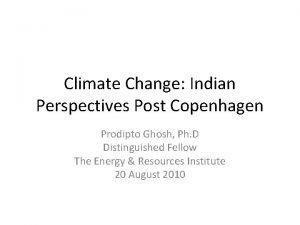
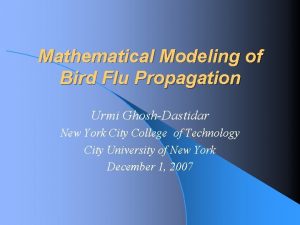
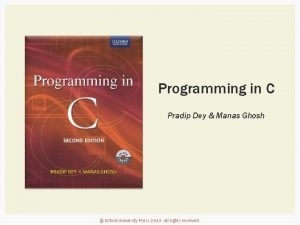
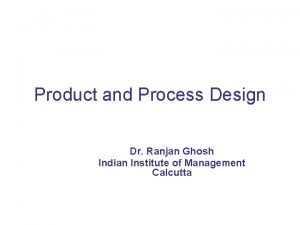

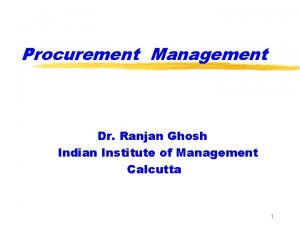

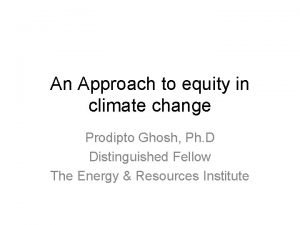
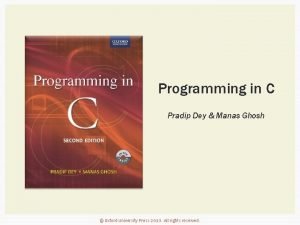
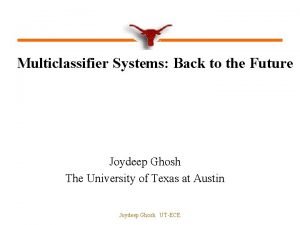




![What is the z - transform of anu[n] and -anu[-n-1] What is the z - transform of anu[n] and -anu[-n-1]](https://slidetodoc.com/wp-content/uploads/2020/12/2676408_bc1105d747f6a28db864208443624449-300x225.jpg)







